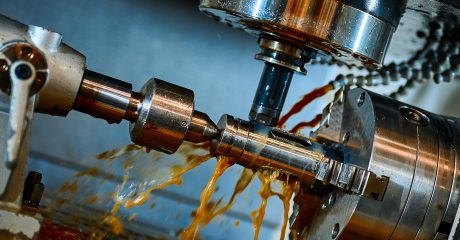Lathe cutting tools are tools you can use with a lathe machine to produce turned parts and materials in the desired shape. They are an important part of CNC machining. However, there isn’t much information out there on using them. Therefore, this article will touch on different types of lathe tools seen in CNC turning.
What is a Lathe Machine?
A lathe is a machining tool that can rotate and cut metal or wood into the desired shape. It uses stationary lathe cutting tools to perform several operations, such as turning, undercutting, knurling, drilling, facing, boring, and cutting. This machine is often used to remove the excess material from the workpiece to achieve a specified size and shape.
Classifications of Lathe cutting tools
Classification by Material
- High-speed steel tool – As the name sounds, the lathe machine tool is made of high-speed steel, which can maintain hardness while being exposed to service temperatures up to 1000° F. Therefore, they are ideal for rough machining and semi-finish machining.
- Carbide tool – The cutting edge of this tool comes from carbide. Therefore, they it’s ideal for cutting iron, plastic, glass, stone, steel, and other difficult materials.
- Diamond Blade – Diamond is a very hard and wear-resistant material. It has a low coefficient of friction, high elastic modulus, high thermal conductivity, and low thermal expansion coefficient. Consequently, the lathe tools with diamond cutting edges are ideal for precision machining of brittle, wear-resistant, conforming, and hard materials.
Classification of Lathe Cutting Tools by Use
- Turning Tool – There are two general types of turning tools in terms of their uses: rough turning tools and finish turning tools. Rough turning tools are used for removing large parts of a workpiece in a very short time. They have a ground cutting angle that allows the removal and they can withstand maximum cutting pressure. Finish turning tools are used for removing small parts of the workpiece. The angle is ground and according to its name, the end product has a smooth surface.
- Boring Tool – This type of lathe tool is inserted into a pre-existing hole and used to widen the hole’s diameter.
- Chamfering Tool – Chamfering tools are used for creating a furrow on a part. It can also be used to create smooth or hazardous edges on a workpiece.
- Knurling Tool – This type of lathe tool can produce knurled lathe parts by creating a specific pattern into a round section. Therefore, allowing you to use them as a grip for handles or fasteners like nuts.
- Thread Cutting Tool – This cutting tool does exactly what its name implies – it cuts threads on a lathe part. There are two general forms: internal and external thread cutting. External thread cutting involves the workpiece being held in a chuck or mounted between two centers. However, in internal thread cutting, the part is held in a chuck while the tool moves across it in a linear format taking chips off the workpiece as it passes it.
Classification of Lathe Cutting Tools by Method of Applying Feed
- Right-Hand Tool – A right-hand tool removes material when moving from right to left. The name right-hand tool was used based on the human hand analogy. Using the right human hand, the thumb represents the tool feed direction. Therefore, the principal cutting edge of the tool is on the tool’s left side.
- Left-Hand Tool – Unlike a right-hand tool, the left-hand cutting tool removes material when moving from left to right. Given the human hand analogy above, the thumb represents the tool feed direction. Therefore, the principal cutting edge of the tool is on the tool’s right side.
- Round Nose Tool – A round nose turning tool has no back rake or side rake. Therefore, the tool is fed from the left to the right end of the late bed or vice versa. Due to the round edge, round nose turning tools are popular tools in finish turning operation.
Conclusion
Lathe cutting tools are an important part of any CNC machining. However, there are many types of cutting tools available with no distinct disparity. To simplify it, this article has showcased the different classifications of lathe tools. If you are still not sure which type of lathe machine tools can lead to your desired shape, fill out our “Contact Us” form to get professional suggestions from our expert team.
